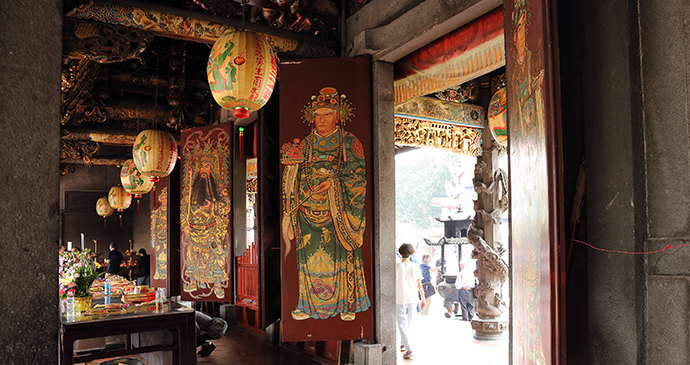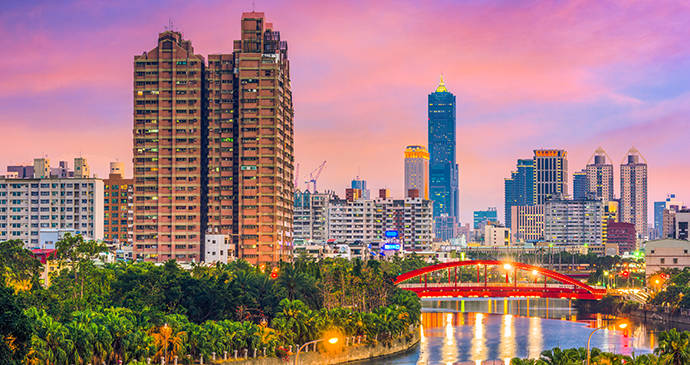Highlights

Your first impressions of Taiwan may be of overcrowded urban areas and a bewildering lack of English once you leave the airport but with a little nudging the door to the treasure house opens. Taiwan not only has a tremendous range of attractions – cultural, scenic and ecological – but also great depth in every category. Two weeks isn’t nearly enough to do justice to its mountains, museums, minorities, temples or birds.
A personal top 6: nature and the outdoors
East Taiwan
Hualien to Taitung by Highway 11 is many cyclists’ favourite but the inland route brings you closer to the region’s indigenous population.
Little Liuqiu Island
The coral chunk, Little Liuqiu Island, is near enough to Kaohsiung to make an excellent day trip, yet far enough from ‘mainland’ Taiwan to have a completely different vibe.
New Central Cross-Island Highway
The high-altitude road that connects Sun Moon Lake with Yushan National Park and Alishan more than justifies renting a car or hiring a driver.
Penghu County
Straight, empty roads link sandy beaches, crumbling coral houses and superb windsurfing spots are what make up Penghu County.
Snow Mountain
Taiwan’s number two peak in terms of height is a world-class three-day hike offering stunning vistas.
Taroko Gorge
You’ll understand why Taroko Gorge is called a ‘must-see’ as soon as you reach Swallow Grotto or the Tunnel of Nine Turns.
A personal top 6: culture and man-made attractions
Temple culture
The fervour and colour of Taiwan’s tang-ki and zhentou are unforgettable.
Kinmen County
Staggeringly quaint villages scarred by Cold War battles.
Lukang
Get lost in the backstreets of Lukang; Taiwan’s living museum.
National Museum of Taiwan History
Whether you know nothing about Taiwan’s past or have immersed yourself in the subject, you’ll find this museum very satisfying.
National Palace Museum
The cream of the artistic output of one of the world’s oldest and most accomplished civilisations.
Tainan’s Martial Rites Temple
The most exquisite shrine in a city famous for temples. Tainan is a place of supreme tranquillity and refinement.
Suggested itineraries

Spend weekdays exploring the countryside, the mountains and little towns like Lukang and Tamsui; spend weekends and national holidays in the major cities. Many scenic spots are all but deserted in the middle of the week; room rates are lower and there are some discounts on admission charges. Note that many museums close on Mondays.
A long weekend
As many Asia-based Western expatriates are discovering, a long weekend in Taiwan is very feasible. Fly to Taipei for culture or Kaohsiung for outdoors adventure. The capital has more than enough shops, restaurants and museums to keep you out of mischief, and for glimpses of tradition you needn’t go beyond the city limits. Baoan and Longshan temples are among Taiwan’s most interesting shrines. Dihua Street, where business is still done the way it was a hundred years ago, nicely counterpoints the city’s department stores and boutiques. Central Kaohsiung has its attractions but if time’s limited, speed away from the city, either towards the hills, or down to the beaches and beautiful hinterland of Kenting National Park.
One week
Try to hit at least two but not more than three of the following: Taipei, Tainan, Taroko Gorge and somewhere in the high mountains. If you restrict yourself to the northwest, you’ll probably be able to take in the woodcarving centre of Sanyi and possibly an indigenous village. Those staying in the south should get their own transport, and drive or ride towards Taitung. The return leg to Kaohsiung can be via Kenting National Park.
Two weeks
Ease yourself in with a full three days in and near your city of arrival, then rent a car or a motorcycle for a week so you can traverse the Central Mountain Range by whichever road takes your fancy. When you reach the east coast stop at a hot springs if the weather’s cool, or a mountain creek if it isn’t. Spend up to three days in Taroko Gorge. To find solitude or something close to it, arrive on Green Island or Orchid Island on a weekday. Consider hiking into the eastern part of Yushan National Park before heading back to western Taiwan by any mountain road you haven’t already seen. If you’ve no intention of braving the roads, get to grips with the bus schedule or find a tour operator who can transport you to and around the hills. Do this because if you leave having seen only the places served by trains, you won’t have seen the best of Taiwan.